Elizabeth Carter
Elizabeth Carter (pen name Eliza; 16 December 1717 – 19 February 1806) was an English poet, classicist, writer, translator, linguist, and polymath. As one of the Bluestocking Circle that surrounded Elizabeth Montagu,[1] she earned respect for the first English translation of the Discourses of Epictetus, by the 2nd-century Stoic philosopher.[2] She also published poems and translated from French and Italian. Most of her other literary output took the form of correspondence to family and friends.[3] Carter had many eminent friends and was close to Elizabeth Montagu, Hannah More, Hester Chapone, and other Bluestocking members. Anne Hunter, a minor poet and socialite, and Mary Delany were also noted as close friends.[4] She befriended Samuel Johnson, editing some editions of his periodical The Rambler.
Elizabeth Carter | |
|---|---|
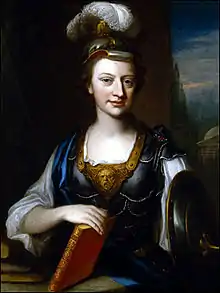 | |
| Born | 16 December 1717 Deal, Kent, England |
| Died | 19 February 1806 (aged 88) Clarges Street, Piccadilly, City of Westminster, England |
| Pen name | Eliza |
| Occupation | Poet, classicist, writer, translator |
| Language | English |
| Nationality | English |
| Literary movement | Bluestocking Circle |
| Notable works | All the Works of Epictetus, Which are Now Extant |
Early life and education
Born in Deal, Kent, 16 December 1717, Elizabeth Carter was the oldest child of Rev. Nicolas Carter, perpetual curate of Deal,[5] and his first wife, Margaret (died c. 1728), who was the only daughter and heir of Richard Swayne of Bere Regis, Dorset. She died when Elizabeth was ten.[6][7] Her redbrick family home can still be seen at the junction of South Street and Middle Street, close to the seafront.
Nicolas Carter himself undertook the labour of educating his numerous children in the Latin and Greek languages. His eldest daughter was so slow to understand her lessons that he almost despaired of ever making her a scholar, and would have given up the attempt but for her resolute perseverance as a child, in which she struggled incessantly against all obstacles. From an early age her ambition was to be good and learned, and she steadfastly pursued that goal through life. She could never acquire grammar as a rudimentary theory, but having attained great proficiency in the Greek and Latin languages – being especially proficient in Greek[8] – she deduced the principles from the literature. Her father also taught her Hebrew.[9] In order to assist her in acquiring French, her father sent her to board for a year in the family of M. Le Seur, a refugee minister at Canterbury, where she learned both to understand and to speak it with fluency. She subsequently applied herself to Italian, Spanish, German, and Portuguese, and very late in life, she learned enough Arabic to read it without a dictionary.[5]
Being naturally heavy, and resolved to stay awake as long as possible in pursuit of her studies, she had recourse to use snuff, and was never able to break herself of the habit. Over-application to her studies and lack of sleep brought on intense headaches, to which she remained subject through life. Her taste for literature was formed upon the finest models available, while her refined manner and habits were formed by an early introduction to high society.[10]
She carefully studied astronomy, and the geography of ancient history. She learned to play the spinnet and the German flute, and was fond of dancing in her youth. She drew tolerably well, was acquainted with household economy, loved gardening and growing flowers, and occupied her leisure or social hours with needlework.[11] In the hope of counteracting the bad effects of too much study, she habitually took long walks and attending social parties.[11]
Friendships
Elizabeth Robinson, born in 1720, was the eldest daughter of Matthew Robinson, 2nd Baron Rokeby, who had married the heiress of the Drakes of Horton, near Hythe. Elizabeth spent a great part of her childhood there, and was early attracted by sympathy of feeling and similarity of pursuits towards her young contemporary and neighbour, Elizabeth Carter. A close friendship was formed between them, which lasted to the end of their long lives. In the year 1742, Robinson married Edward Montagu, a grandson of the second Earl Of Sandwich; and subsequently to that event, Carter often visited her at her country seat at Sandleford and at her house in London.[12]
In 1741 she began her acquaintance with Catherine Talbot, which became a close friendship for they appreciated each other's faculties, virtues, and piety. Through Talbot and her mother, she came into contact with Thomas Secker, with whom they resided. He was then Bishop of Oxford, and became the Archbishop of Canterbury in 1758.[11]
Career
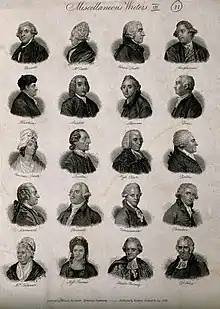
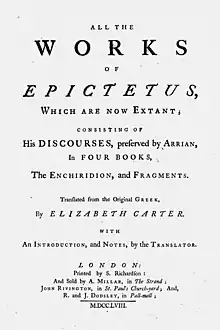
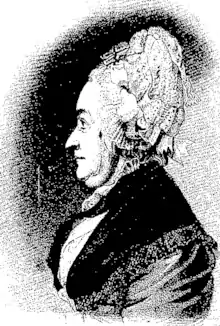
Her earliest attempts at literary composition were in verse. Her father was friendly with Edward Cave, the publisher,[7] in whose fourth volume of The Gentleman's Magazine, she published several pieces, under the pseudonym of “Eliza,” when she was only sixteen years old. Visiting London occasionally with her father, she was introduced by Cave to many literary persons, and among the rest to Dr Johnson, soon after his first settling there in the year 1737. In 1738, she published an anonymous collection of her poems, including those which had been previously printed in The Gentleman’s Magazine. In the same year, her father had had conversations with Carter about marriage, and again a few years later, but she never married, wishing instead to remain independent.[13] She adopted the matronly designation "Mrs" after the manner of an earlier generation.[11] Carter rendered into English De Crousaz's Examen de l'essai de Monsieur Pope sur l'homme (Examination of Mr Pope's "An Essay on Man", two volumes, 1739); Algarotti's Newtonianismo per le dame (Newtonianism for women).[10]
Early in the year 1749, she commenced her translation of All the Works of Epictetus, Which are Now Extant, which she submitted sheet by sheet to Secker's revisal. She finished the Discourses in December 1752, but at his suggestion added the Enchiridion and Fragments, with an introduction and notes. A subscription having been got up by him and her other wealthy and influential friends, the work was published in 1758,[14] Carter's position in the pantheon of 18th-century women writers was ensured by her translation of Epictetus, the first English translation of the known works by the Greek Stoic philosopher, and it brought her in a clear profit of £1,000. This translation passed through three editions and retained a high reputation in standard literature.[15] While she was occupied in preparing the first edition for the press, Carter was also preparing her youngest brother for the University of Cambridge.[11]
Carter befriended Samuel Johnson, editing some editions of his periodical The Rambler in the 1750s.[16] He wrote, "My old friend Mrs. Carter could make a pudding as well as translate Epictetus from the Greek..."[1][17]
Style and themes
Her sound and comprehensive mind, highly cultured as it was, could produce nothing bad, but it lacked the essential qualifications of the true poet: active originality, the power of conceiving, and of shaping new conceptions. Her poems demonstrated regularity of numbers, and the well graduated succession of thoughts.[18]
Carter's biographer published an extensive selection from her thirty years’ correspondence with Talbot, and her correspondence with Mrs Agmondesham Vesey between the years 1763 and 1787, in two quarto volumes. Carter's letters were noted for correct, perspicuous, and appropriate language; for soundness of judgment, moderation of spirit, deep sincerity, and pervading piety. Her cheerful disposition was evidenced not only in her sentiments and opinions, but in her occasional expressions of buoyant gaiety where there was always something awkward, forced, and exaggerated.[3]
Carter kept an interest in religious matters. She was influenced by Hester Chapone, and she wrote apologetic treatises of the Christian faith, asserting the authority of the Bible over human matters. One of these works, known as Objections against the New Testament with Mrs Carter's Answers to them and was published in the compilation of writings Memoirs of the Life of Mrs Elizabeth Carter by Montagu Pennington, which included her Notes on the Bible and the Answers to Objections concerning the Christian Religion. Her deep belief in God also appears in her poems "In Diem Natalem" and "Thoughts at Midnight" (also known as "A Night Piece").
At the suggestion of William Pulteney, 1st Earl of Bath, who took great delight in her conversation and writings, Carter published another volume of poems in 1762, to which George Lyttelton, 1st Baron Lyttelton contributed a poetical introduction.[19]
In August 1768, her friend Archbishop Secker died; in November 1769, her friend Miss Sutton died; and in 1770, her best friend Catherine Talbot died.[19] In the same year, Carter edited and published a volume of Talbot's papers, under the title of Reflections on the Seven Days of the Week; and subsequently, two volumes of Essays and Poems.[3]
Nine Living Muses
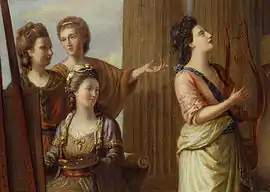
Carter appeared in the engraved (1777) and painted (1778) versions of Richard Samuel's The Nine Living Muses of Great Britain (1779) but the figures in the painting were so idealised that she complained she could not identify herself or anyone else in the work. Samuel had not done any sittings from life when preparing the work.[20] Fanny Burney is quoted in Boswell's Life of Samuel Johnson as saying in 1780 she thought Carter "a really noble-looking woman; I never saw age so graceful in the female sex yet; her whole face seems to beam with goodness, piety, and philanthropy." However, Betsey Sheridan, sister of the playwright, described her five years later in her diary as "rather fat and not very striking in appearance".[6]
Reception
Carter's difficulties were all confined to her books of private study; she met with no discouragements from the outer world.[12] Her translations were approved, her verses were applauded by Burke, Dr. Johnson, Savage, and Baratier; and she found herself courted by many members of learned society.[12] In 1782, at the desire of her friend, Sir W. J. Pulteney, she accompanied his daughter to Paris, but she returned home in sixteen days, and limited her subsequent journeys to British soil. She was repeatedly honoured at Deal with visits from various members of the royal family. The Queen, who had long been accustomed to ask her opinion upon books via ladies of the court, at last, in 1791, commanded her attendance at Cremorne House, where the translator of Epictetus was formally presented and received with the highest favour.[18]
Personal life and other activities
In 1763, she accompanied the Earl of Bath and Edward and Elizabeth Montagu on a continental tour. They crossed the Channel to Calais, visited the Spa, passed down the Rhine, and, travelling through Brussels, Ghent, Bruges, and Dunkirk to Calais, re-crossed to Dover, after an absence of nearly four months. In the summer of 1764, Lord Bath died; and as he made no mention of Elizabeth Carter in his will, the ultimate heir to his property, Sir William Johnson Pulteney, spontaneously settled upon her an annuity of £100, which he soon afterwards increased to £150.[19]
Her father having lost his second wife, and his other children being all settled in homes of their own, Carter bought a house at Deal in 1762. Her father rented part of it,[21] while she managed the household. They had their separate libraries, and spent their studious hours apart, meeting at meals, and spending their evenings together during periods of six months. The other half of the year she usually passed in London, or in visiting her friends at their country houses.[22]
After her father's death in 1774, a small inheritance fell to her.[23] In 1775, Edward Montagu died and his wife Elizabeth inherited a large property. Among her first acts was to bequeath an annuity of £100 to Carter. Mrs Underwood, a family connection of the Carters, afterwards bequeathed to Carter an annuity of £40; and Mrs Talbot dying in 1783, left her the sum of £200 as a legacy. Thus not only did Carter attain literary fame, she acquired, by means which she could never have anticipated, a secure income for her wants and needs.[23]
Carter was a member of the Society for Effecting the Abolition of the Slave Trade (also known as the Abolition Society or Anti-Slavery Society).[24]
Later years and death
In 1796, Carter had a dangerous illness, from which she never thoroughly recovered. She continued, however, to exert herself in visiting the poor, as well as in the establishment and maintenance of charitable institutions. In the year 1800, her faithful friend, Mrs Montagu, died at the age of eighty. Their correspondence, from 1755 to 1799, was published after Mrs Carter's death by her nephew, Mr Pennington.[18]
As with her bluestocking contemporaries, Carter lived a long life.[25] Deafness increasing with age reduced her conversational abilities.[11] On 19 February 1806, after a long period of gradually increasing weakness, Carter died at her lodgings in Clarges Street, London.[7][18]
Influence and legacy
The novelist Samuel Richardson included Carter's poem "Ode to Wisdom" in the text of his novel Clarissa (1747–48) without ascribing it to her. It was later published in a corrected form the Gentleman's Magazine and Carter received an apology from Richardson.[6]
Elizabeth Gaskell, the 19th-century novelist, refers to Carter as an epistolatory model, bracketing her in Cranford with Hester Chapone, a self-taught Bluestocking.[26] Virginia Woolf saw her as a feminist precursor – urging "homage to the robust shade of Eliza Carter – the valiant old woman who tied a bell to her bedstead in order that she might wake early and learn Greek."[27]
References
- Encyclopaedia Britannica Retrieved 13 July 2016. Archived 5 October 2016 at the Wayback Machine
- Barbauld 2001, p. 186.
- Williams 1861, p. 213.
- Bettany, George Thomas (1891). . In Lee, Sidney (ed.). Dictionary of National Biography. 28. London: Smith, Elder & Co.
- Williams 1861, p. 207.
- 18th C – People & Places Retrieved 13 July 2016. Archived 26 August 2016 at the Wayback Machine
- Lonsdale 1990, p. 165-67.
- Moulton 1910, p. 491.
- Uglow 1998, p. 26.
- Williams 1861, p. 208.
- Williams 1861, p. 210.
- Williams 1861, p. 209.
- Lonsdale 1990, p. 165-66.
- Dykeman 2013, p. 209.
- Susan Staves, A Literary History of Women's Writing in Britain, 1660–1780 (Cambridge University Press: Cambridge, 2006) pp. 309–15.
- Lezard, Nicholas (26 February 2005). "Review of Dr Johnson's Women, by Norma Clarke". The Guardian. Archived from the original on 29 November 2005. Retrieved 8 March 2008.
- "Gallery rediscovers oil portrait". BBC News. 6 March 2008. Archived from the original on 9 March 2008. Retrieved 8 March 2008.
- Williams 1861, p. 215.
- Williams 1861, p. 212.
- Peltz, Lucy, "Living muses: Constructing and celebrating the professional woman in literature and the arts" in Brilliant women: 18th-century bluestockings. (2008) Elizabeth Eger and Lucy Peltz (eds.) New Haven: Yale University Press. p. 61. ISBN 9780300141030
- Lonsdale 1990, p. 166.
- Williams 1861, p. 211.
- Williams 1861, p. 214.
- Ditchfield, G.M. (24 May 2007). "Society for the Purpose of Effecting the Abolition of the Slave Trade". Oxford Dictionary of National Biography. doi:10.1093/ref:odnb/92867.
- Eger 2013, p. 100.
- Cranford, Chapter V--Old Letters
- V. Woolf, A Room of One's Own (London 1929) p. 98.
Attribution
- Chisholm, Hugh, ed. (1911). . Encyclopædia Britannica (11th ed.). Cambridge University Press.
 This article incorporates text from a publication now in the public domain: Cousin, John William (1910). "Carter, Elizabeth". A Short Biographical Dictionary of English Literature (Public domain ed.). London: J. M. Dent & Sons.
This article incorporates text from a publication now in the public domain: Cousin, John William (1910). "Carter, Elizabeth". A Short Biographical Dictionary of English Literature (Public domain ed.). London: J. M. Dent & Sons.  This article incorporates text from a publication now in the public domain: Gilman, D. C.; Peck, H. T.; Colby, F. M., eds. (1905). "Carter, Elizabeth". New International Encyclopedia (1st ed.; Public domain ed.). New York: Dodd, Mead.
This article incorporates text from a publication now in the public domain: Gilman, D. C.; Peck, H. T.; Colby, F. M., eds. (1905). "Carter, Elizabeth". New International Encyclopedia (1st ed.; Public domain ed.). New York: Dodd, Mead.  This article incorporates text from a publication now in the public domain: Moulton, Charles Wells (1910). 1785–1824 (Public domain ed.). Moulton.
This article incorporates text from a publication now in the public domain: Moulton, Charles Wells (1910). 1785–1824 (Public domain ed.). Moulton.  This article incorporates text from a publication now in the public domain: Williams, Jane (1861). The Literary Women of England (Public domain ed.). Saunders, Otley and Co. p. 207.
This article incorporates text from a publication now in the public domain: Williams, Jane (1861). The Literary Women of England (Public domain ed.). Saunders, Otley and Co. p. 207.
Bibliography
- Barbauld, Anna Letitia (24 September 2001). Anna Letitia Barbauld: Selected Poetry and Prose. Broadview Press. ISBN 978-1-77048-070-4.
- Dykeman, T. (29 June 2013). The Neglected Canon: Nine Women Philosophers: First to the Twentieth Century. Springer Science & Business Media. ISBN 978-94-017-3400-4.
- Eger, Elizabeth (21 November 2013). Bluestockings Displayed. Cambridge University Press. ISBN 978-0-521-76880-1.
- Lonsdale, Roger H. (1990). Eighteenth Century Women Poets: An Oxford Anthology. Oxford University Press. ISBN 978-0-19-282775-3.
- Uglow, Jennifer S. (1998). Dr Johnson, His Club and Other Friends. National Portrait Gallery. ISBN 978-1-85514-232-9.
- "Elizabeth Carter", Tulsa Studies in Women's Literature, Vol. 5, No. 1 (Spring, 1986), pp. 138–140
- "Home town finds feminist painting". BBC News. 7 March 2008. Retrieved 8 March 2008.
External links
- Elizabeth Carter at the Eighteenth-Century Poetry Archive (ECPA)
- Portraits of Elizabeth Carter at the National Portrait Gallery
- Works by or about Elizabeth Carter at Internet Archive
- Works by Elizabeth Carter at LibriVox (public domain audiobooks)

- Hutchinson, John (1892). . Men of Kent and Kentishmen (Subscription ed.). Canterbury: Cross & Jackman. pp. 29–30.